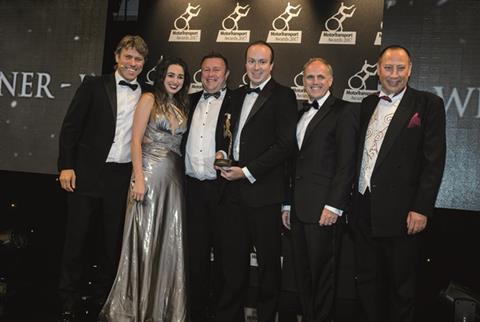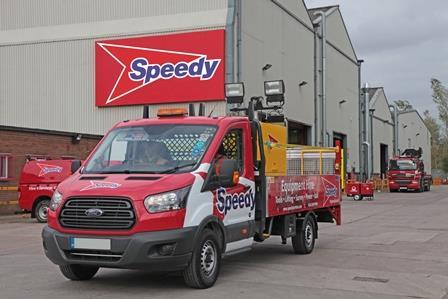
Speedy Services has a creative outlook to problem solving, an open mind about business solutions, and a focus on providing the best for its team and customers.
Brand loyalty among fleets is not uncommon, as the relationship built between operator and supplier is key to running a successful and profitable business. Mark Woodworth, head of transport and logistics at Speedy Services, runs a fleet approaching 1,000 vehicles, more than 800 of which are
vans.
Winner of this year’s Fleet Van Operator of the Year award, over the past 18 months Speedy has demonstrated an unerring commitment to the safe running and development of its fleet, while investing in innovative ways to increase fleet use and reduce its environmental impact.
Operating an entirely Ford Transit-based fleet, Speedy has adapted what it needs from its vehicles, working closely with the manufacturer to get the best vehicle possible for the job. The
fleet is made up of 70% drop-sided Transits because it cannot use a standard van for transporting much of the equipment it provides.
“The Ford product works really well for the company,” Woodworth said. “Tools and equipment hire is our main business, and our main involvement is picking up [equipment]. We’ve always run Transits, and coupled with the bodies from PPS, they are probably the best vans we’ve ever had.”
Built on a standard Transit chassis with a PPS Commercials body, the Speedy fleet has been moving to Euro-6-compliant vans, where Woodworth said payload has been severely affected by the additional systems and fluids needed to meet the emissions regulations.
“We need as much payload as possible. The van has got heavier and so has our kit as both are getting more complicated as technology improves. Anything that carries fuel now needs to be Euro-6, so vans carry less. We use DEL tail-lifts with plastic mesh rather than steel or aluminium [guard rails] to remove weight, and we take ancillary items off the vans to save more weight. We’ve removed just about everything possible including the second passenger seat, which means we can carry more. I wish we had done it three or four years ago.”
Drivers
It’s not just the vans that are under strict scrutiny, the drivers are also expected to perform to a high standard. Our judges noted Speedy’s driver training introduced in-cab feedback on individual driving styles through telematics, as well as training courses to improve professionalism among staff.
Woodworth believes his van drivers are the C+E drivers of tomorrow, and expects them to drive their
vans accordingly. He said Speedy is looking at taking drivers from vans to C+E, and has started putting the first few through training.
“Getting a good apprentice in the truck world is hard, and training them to do HIAB [crane deliveries] with ADR is almost impossible. The range of work we carry out in the multi-service centre means we need 'do-it-all drivers' and to get people who are willing to do all of those jobs is hard. A truck driver might think it’s beneath them to drive a van, while an ADR tanker driver might not want to operate a crane," said Woodworth. "Over 18 months the apprentices are put through vans, manual handling, HIAB and ADR, and then their C licence.
"At that point, they can drive the majority of our fleet. Then in the last six months they do their C+E, that way, in two years they’re a fully qualified driver. The drivers are then willing to do anything because they have done it before.”
Monitor
Once on the roads, Speedy’s driver training and assessment programme will monitor drivers. Using Masternaut Telematics’ Connect system, a light bar in the cabin provides realtime feedback on their driving performance.
A fob system logs who is driving the vehicles and according to where the vehicle is driving, a prescribed set of parameters as to how the vehicle should be driven is applied. That way drivers in London can be instructed differently to drivers in, say, Manchester.
“They start with 100 points and have to end the day on 100 points or more. Points get taken away for braking heavily or accelerating too hard, but sometimes that is needed. We don’t want them to reach 100 and then worry about losing points, so they can continue to get points throughout the day and if they have to brake then their points don’t drop below the target," said Woodworth. "It’s a fair system, and once they’re at that level you can make the parameters a little bit harder. It allows them to improve.”
Improving driving standards to increase fuel efficiency and enhance road safety is only one part of the company’s drive to make better use of its vehicles. Speedy also examined the way it used its vehicles, and in June 2015 overhauled how it transported goods. Having reviewed its logistics network, Speedy redesigned the way it moved assets internally, changing routes to reduce its annual mileage.

Using local knowledge, experience and its IT systems, between January 2016 and January 2017 vehicle use increased by 32%, ensuring the correct types of vehicles were used for specific location or load deliveries.
“We now operate a hub-and-spoke network rather than a go-and-fetch it yourself in a van policy. Every depot can see what others in the region have, so they can see where vehicles and equipment are and be more efficient in where and how they collect items. We’re moving equipment on a truck between hubs, rather than on individual vans. The mileage has gone up on the trucks, but by using them at night we’re increasing efficiency and have reduced the van fleet by 150.”
Safety
The safe running of the fleet is of great importance and with its sizeable and varied fleet, Speedy and Woodworth have a tougher job than most in ensuring drivers stay compliant. As a result, Speedy has developed an app that drivers use as part of their daily checks. To many truck operators and for a fleet of Speedy’s size, that doesn’t sound that unusual, but rather than assist in the walk-around checks, the app logs how long is spent doing checks and files a report, as well as asking the driver a series of questions about the vehicle to ensure it is fit for use.
A barcode helps identify what the vehicle is, and as the questions are asked, any problems are more easily identifiable to the driver, even if they are unfamiliar with the vehicles.
“If a driver is driving a tanker there are a lot more questions than he has on his Connect van,” Woodworth explained. “In each vehicle there is a barcode, and it tells the driver what type of vehicle it is, and that is matched to a set of questions – a beavertail compared to a box body will have different questions. If they have to hook up to a trailer it asks them questions about the trailer. We also use it for timing the walk-around check – if it’s less than a set time we start to question it.”
Facing some tough competition in the Fleet Van Operator category from Gnewt Cargo and Sainsbury’s Online, one thing stood out to the judges during their discussions. A small mention of an electrified BMW van being trialled by the company took everyone by surprise. Woodworth said it was brought about through wanting greener vehicles, but disillusioned by the choices on offer and unsure of how it would fit into the business operation, Speedy turned to one of its fleet car providers for a solution.
The BMW i3 was used on the car fleet, and with its range extender petrol-electric drivetrain it fitted perfectly into the sort of work Woodworth was hoping an electric vehicle would fill. The greater range offered over a full electric vehicle was a key benefit, but also by removing rear seats and transforming it into a conventional-looking light commercial vehicle loadspace, Speedy unleashed a 600kg payload – more than enough for the emergency on-call fitter or time-critical delivery to a site.
Going electric
Woodworth joined Speedy in 2011, initially in IT projects managing the Masternaut Telematics installation, and he and his colleagues have thoroughly changed the way Speedy approaches its fleet. He said the biggest challenge has been the weight gains of Euro-6 vehicles and maintaining the payloads needed for smooth running of the fleet. But he now has one eye on the future with the i3 vans just the start of a wider investigation into greener transport at Speedy.
“It’s [the electric vehicle] worked and we’ve seen the benefit. I’ve learned more about electrification in the past six months than all of the six years before that,” he said.
The industry is moving at such a pace that holding out has proved a smart decision, as the speed of innovation increases and the technologies become more mainstream. As OEMs have begun to jump on board with electric drivetrains and their own low-emission solutions, now is the time for Speedy to begin to explore greener fleet solutions, and who better to do it than its long-standing partner, Ford.
Speedy will be one of a handful of customers to trial Ford’s new Transit Custom Hybrid. The trial will last between six and 12 months, and Woodworth said they will be taking the place of fitters’ vans in Dartford, covering the London to Canterbury area. They’ll be doing the normal working jobs of breakdowns and repair on site, as well as being service vans for generators.
“We’re hoping to see how the hybrid world has come on since the i3. I would like to see the next step of electrification; there’s a 25- to 30-mile range in the i3 and I’m hoping to see that range increased in the bigger van,” said Woodworth.
If Speedy adopted hybrid vans it would be a major coup for Ford. But Woodworth has the payload conundrum to consider, and could it fit into Speedy’s working practices? Woodworth is positive they would, but reluctant to completely reveal his hand. As they stand, full electric vehicles wouldn’t work – a van would need a genuine 150-mile range, no doubt with a hefty payload. For the manufacturer that can deliver such a spec, Woodworth estimates 150 of his vans could be switched to electric.
Watchful eye
For now, Woodworth is content to watch the story unfold while keeping a watchful eye on payloads, improving driver training and attending the company’s fortnightly accident review groups. The handful of minor accidents that do occur are analysed, scrutinised and frequently designed out by altering the vehicles.
In the meantime, until Ford (or another manufacturer) can deliver a high-mileage, accident proof electric vehicle, with the perfect fuel efficient and safe driver, Woodworth has plenty to do leading Speedy’s fleet forward as a model fleet van operator.











